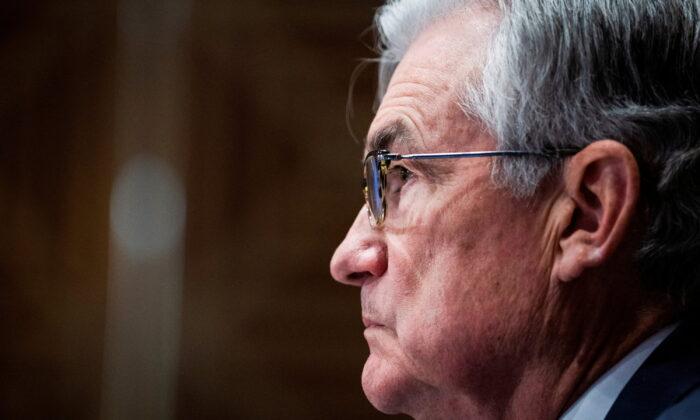Federal Reserve Chair Jerome Powell says it is “absolutely essential” to trim inflation while also accomplishing a “soft landing.”
Speaking during the panel, the head of the U.S. central bank noted that the global economy would endure the effects of the Ukraine–Russia war, particularly on the inflation front. The U.S. economy, however, is less vulnerable to the military conflict in Eastern Europe, Powell said.
At the same time, he conceded that the job market is too hot and “unsustainable,” which is “very good” for workers.
Overall, he believes the post-pandemic U.S. economy is doing well, but the caveat is that the country will not return to the “old pre-pandemic economy.” That said, the general economic strength in the United States could support a more aggressive approach to monetary policy.
“It is appropriate, in my view, to move a little more quickly on interest rates,” Powell said, adding that a half-percentage-point increase at the May policy meeting is on the table.
On the topic of globalization, Powell conceded it is evident globalization has “slowed down” and that it might enter into “reverse.” Moving forward, however, the global economy might endure higher inflation for longer.
The Fed chief also pointed out that the financial markets are “reacting appropriately to our communications.”
U.S. stock indexes wiped out their gains ahead of the event as the Dow Jones, S&P 500, and the Nasdaq slipped into negative territory.
Treasury yields added to their gains Thursday, with the benchmark 10-year yield up 0.099 percent to 2.93 percent. The one-year bill rose 0.079 percent to 2.015 percent, while the 30-year bond advanced 0.073 percent to 2.949 percent.
The U.S. Dollar Index (DXY), which gauges the greenback against a basket of currencies, turned positive in the afternoon, rising 0.1 percent to 100.49.
Powell spoke earlier in the day, recognizing former Fed Chair Paul Volcker, saying that he “left a strong legacy.”
Be Aggressive or Be Cautious?
This week, many Federal Reserve officials have been spotlighting their more aggressive attitude to tightening U.S. monetary policy.In a virtual session hosted by the Bendheim Center for Finance at Princeton University, St. Louis Fed Bank President James Bullard reiterated his perspective that the central bank is behind the curve on inflation, “though we’re not as far behind as you think.”
This comes after he explained that inflation is “far too high” and that there could be a case to be made that a 75-basis-point hike is needed.
“More than 50 basis points is not my base case at this point,” Bullard told a virtual Council on Foreign Relations (CFR) presentation. “I wouldn’t rule it out, but it is not my base case here.”
Mary Daly, the president of the Fed Bank of San Francisco, stated that the central bank is poised to increase the benchmark rate to 2.5 percent by the year’s end to calm down rampant price inflation.
At the same time, he said it is imperative to refrain from accelerating too fast, as it could potentially tip the economy into a recession.
Daly also highlighted the financial strain facing consumers and businesses in today’s inflationary environment.
“Across the country, Americans are waking up and going to bed worried about whether their incomes will keep up with the rising cost of rent, food, and fuel,” she said.
“Businesses are also worried, thinking twice about committing to long-term contracts that may become too costly to fulfill, if prices continue to rise.”
If the institution raises rates to 2.5 percent by the end of 2022, the Fed could reassess where inflation is, and the overall economy.
“We are moving to adjust it [the fed funds rate] to ‘normal’ and then we will see,” he stated. “The problem is, it [high inflation] is likely to persist if the Fed doesn’t do anything.”
But while some of his colleagues are advocating for more aggression, Atlanta Federal Reserve Bank President Raphael Bostic encouraged the rate-setting Committee “to be cautious” in the face of slowing global economic growth.
“I don’t think it is easy to know for sure how strong the economy is going to continue to be as we move through the summer and into the fall,” he told the business news network.

Bostic did purport, however, that he believes the U.S. economy is strong enough to “stand on its own” without direct fiscal and monetary stimulus.
Earlier this week, the International Monetary Fund (IMF) trimmed its 2022 global growth forecast from 4.4 percent to 3.6 percent.
The top IMF official acknowledged that the Fed may need to pull the trigger on more rate hikes to get a stranglehold on inflation, which would also weigh on consumer demand and the broader economy.
The IMF is not anticipating a recession in the United States, but Adrian is not ruling one out either.
Over the last month, Wall Street firms have been increasing their odds of an economic downturn in the United States. Goldman Sachs raised its recession expectations to 35 percent, while Merk Research placed the chances of a contraction at 1 in 3.





